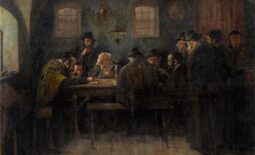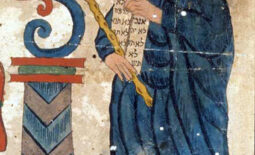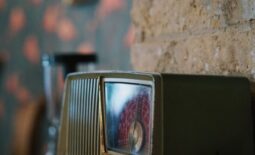D’var on Tsitsit
Note: jLab is for blog posts about creative, fun, or interesting Jewish or congregation-related topics. To submit a post, you must be a member of our congregation, and the topic must be Jew-ish, related to our congregation or the wider Jewish community. If you have something to share, please submit it here.
By Frank Salomon / Pinchas ben Gershon
D’var on Tsitsit (Shelach: Numbers 15:37-41, restated in Deuteronomy 22:11-12)
8 June, 2019
Parshat Shelach (JTS Torah Commentary: v.4 p. 127-138) gives us the mitzvah to make for ourselves fringes on the corners of our garments: fringes to look at and thereby be reminded of all mitzvoth.
I have a special affection for tsitsit because for many years I studied another culture addicted to cords and knots, namely the Incas. This is a simulacrum of a small Inca khipu or knot-cord document. In 1930 Solomon Gandz, a Viennese-trained librarian at Yeshiva University, claimed that Incas and Hebrews had invented in parallel, on separate continents, a common root of all literacy: knotted cord records. Gandz’s conjecture isn’t taken seriously today. Yet neither was it foolish of Gandz to wonder how threads and knots became a way to declare truths without words – and why knotted threads convince and compel us (and the Incas) in a way that seems self-evidently powerful.
Numbers 15 doesn’t talk about knots. It only mentions fringes and the famous blue thread. Ezekiel used the expression tsitsit to mean a lock of hair: וַיִּקָּחֵ֖נִי בְּצִיצִ֣ת (8:3, Alter v.3.1072), “[G/d] took me by the tsitsit of my head–” the outermost extensions of my person.
Robert Alter understood tsitsit to mean “uncut threads extending down from the hem.” This seems to imply long remnants of the textile’s warp, rather than separately made tassels. He apparently thinks of ancient fabric as having an unstructured extension at its edge, like hair.
In other words, as the anthropologist Terry Turner put it, the ego doesn’t stop at the skin in all cultures. It continues outward, as if irradiated into hairs of the skin and even fibers of the garment over skin.
We know (as R. Hugenholz explained in a past d’var) about how in the ancient mideast grasping the hem of a man’s garment was an unrefusable appeal (Zechariah 8:23). One seized upon the outermost extension of his very self.
These outermost substances are neither integral to the person, nor separate from him or her. Hair has no feeling, it can be harmlessly amputated or fashioned; but it never ceases to be part of somebody in particular, down to and including genotype. We notice this idea Judaically, for example, from the fact that some Orthodox women reject human-hair wigs because the hair contains “idolatrous” deeds of the Hindu women from whom it comes (R. Yirmiyahu Ullman, Or Somayach, https://ohr.edu/1698).
So person flows out and out through filaments. Cloth, like hair, is detachable, extendable self. It too can be abandoned or altered. It has no sensation. It reaches a farther remove from ego than hair because it is an artifact. Clothing is inherently more social than hair because in most societies, one wears garments made by others.
Clothing goes out to our closest ones in gestures like giving one’s garment — Joseph’s patrimonial cloak (Genesis 37:3). It goes out to the whole public in fashion messages or in insignia of rank or loyalty. It even goes out to the infinite when the tallis is buried with its owner.
So we can start to think of hair, fringe, or tassel as a transitional zone between the person and society, or the world. It’s our second skin, part self and part other.
In the ancient Mideast and elsewhere this “fringe area” of the garment protected the bare person, yet also defined and constrained her, at the same time as it projected her outward. Along its fibers, intimate personhood shaded into the broader “weave” of society. The impression of a hem could count for a signed guarantee, notes E.A. Speiser, and there are many other instances. Jacob Milgrom (1981) explains that elaborated and extended hems were noble insignia, (1 Samuel 24:3-21). Tsitsit (and especially the royal blue thread) were then a claim for the nobility of Jews as a people – all Jews.
Yet we are left with a big question: in postbiblical Judaism, tsitsit are not the extended warp of our garment, but separately made tassels. At the bottom of a standard tallis, Rabbi Hugenholtz pointed out to me, we do have bunches of tied-off spare warp, like what Alter mentioned – but they are to us just non-halakhic, sub-tallis incidentals. Why does Judaism insist on a further extension of the extension? Why have we made the holy part of our social skin physically almost discontinuous from it? Are we trying to separate the sacred part of our selves at maximum distance from the dangerously intimate, natural, sweaty properties of innerwear — the way a sheytl substitutes for hair?
In Talmud Menakhot 39a-44b the rabbis discussed how much of the mitzvah can be satisfied using the woven body of a personal garment. They conclude, very little. In 41b they agree that the mere lexical meaning of fringe, tsitsit could include a naturally hanging-off edge of something already made, as with Ezekiel’s hair. But they elaborated a consensual opinion that one can never make a valid tsitsit by knotting the remaining warp of a textile that is “already made.” Obeying the mitzvah to “make fringes” means constructing them separately, with a purpose, with a kavanah apart from mere textile production.
Incarnating the consecrated part of personhood in the outermost reach of the “social skin” assures that the wearer and everyone else can “look upon it” (Num. 15:39). So vital is its free visibility that Menachot says even a blind man must wear tsitsit. Why? Because even if the blind man can’t look upon them, others will. And conversely, Menachot says that sleepwear doesn’t need to have tsitsit, because nobody looks on it.
And finally, tsitsit must have knots. I don’t know when tsitsit became necessarily knotted threads. But I suspect that the general reason both Incas and ancient Jews extended the idea of meaningful fringe to include knotting has to do with how it feels to make a knot. When one works cords one holds a standing end and a working end. These may be likened respectively to memory and the working edge of sentience. As awareness moves about, it sometimes crosses its own path and recognizes it. By the intentional act of bending the working end back around and through the recognized point, one binds that instant – one fixes awareness of having been aware. (I can’t finish the knot now, because knotting is one of the 39 melachot one doesn’t do on shabbat.) Binding awareness of having been aware: we start thinking like Jews. Maybe it is in this sense that any tsitsit reminds us of all mitzvoth, as several baraita in Menachot insist.
And so we start thinking like Jews. Shabat shalom.
(all rights reserved)




